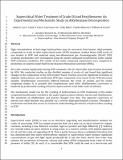| dc.contributor.author | Carr, Adam G. | |
| dc.contributor.author | Class, Caleb Andrew | |
| dc.contributor.author | Lai, Lawrence Tin Chi | |
| dc.contributor.author | Monrose, Tamba E. | |
| dc.contributor.author | Green, William H | |
| dc.date.accessioned | 2016-11-29T18:47:18Z | |
| dc.date.available | 2016-11-29T18:47:18Z | |
| dc.date.issued | 2015-07 | |
| dc.date.submitted | 2015-07 | |
| dc.identifier.issn | 0887-0624 | |
| dc.identifier.issn | 1520-5029 | |
| dc.identifier.uri | http://hdl.handle.net/1721.1/105463 | |
| dc.description.abstract | High concentrations of fuel-range hydrocarbons may be recovered from heavier alkyl-aromatic compounds in crude oil after supercritical water (SCW) treatment. Arabian Heavy (AH) crude oil was treated in SCW and analyzed using two-dimensional gas chromatography (GC × GC-FID). Cracking mechanisms were investigated using the model compound hexylbenzene under similar SCW treatment conditions. The results of the model compound experiments were compared to predictions of a kinetic model built by the Reaction Mechanism Generator (RMG). AH crude cracked significantly during SCW treatment. The GC-observable mass fraction increased by 90%. We conducted studies on the distilled samples of crude oil and found that significant changes in the composition of the SCW-treated heavy fraction occurred. Significant formation of aliphatic hydrocarbons and small-chain BTX-type compounds were found in the SCW-processed samples. Hexylbenzene conversions differed between the crude oil studies and the model compound studies. The mechanistic model for the cracking of hydrocarbons during SCW treatment of the model compound hexylbenzene predicted the observed major liquid products toluene, styrene, and ethylbenzene. The selectivity of ethylbenzene and styrene changed over time. The apparent conversion of styrene into ethylbenzene was possibly via a reverse disproportionation reaction. Ultimately, a mechanism was built that serves as a basis for understanding the kinetics of hydrocarbon cracking in SCW. | en_US |
| dc.description.sponsorship | Saudi Aramco (Contract 6600023444) | en_US |
| dc.language.iso | en_US | |
| dc.publisher | American Chemical Society (ACS) | en_US |
| dc.relation.isversionof | http://dx.doi.org/10.1021/acs.energyfuels.5b01040 | en_US |
| dc.rights | Article is made available in accordance with the publisher's policy and may be subject to US copyright law. Please refer to the publisher's site for terms of use. | en_US |
| dc.source | Prof. William Green | en_US |
| dc.title | Supercritical Water Treatment of Crude Oil and Hexylbenzene: An Experimental and Mechanistic Study on Alkylbenzene Decomposition | en_US |
| dc.type | Article | en_US |
| dc.identifier.citation | Carr, Adam G. et al. “Supercritical Water Treatment of Crude Oil and Hexylbenzene: An Experimental and Mechanistic Study on Alkylbenzene Decomposition.” Energy & Fuels 29.8 (2015): 5290–5302. | en_US |
| dc.contributor.department | Massachusetts Institute of Technology. Department of Chemical Engineering | en_US |
| dc.contributor.mitauthor | Class, Caleb Andrew | |
| dc.contributor.mitauthor | Lai, Lawrence Tin Chi | |
| dc.contributor.mitauthor | Monrose, Tamba E. | |
| dc.contributor.mitauthor | Green, William H | |
| dc.relation.journal | Energy & Fuels | en_US |
| dc.eprint.version | Author's final manuscript | en_US |
| dc.type.uri | http://purl.org/eprint/type/JournalArticle | en_US |
| eprint.status | http://purl.org/eprint/status/PeerReviewed | en_US |
| dspace.orderedauthors | Carr, Adam G.; Class, Caleb A.; Lai, Lawrence; Kida, Yuko; Monrose, Tamba; Green, William H. | en_US |
| dspace.embargo.terms | N | en_US |
| dc.identifier.orcid | https://orcid.org/0000-0001-8866-7739 | |
| dspace.mitauthor.error | true | |
| mit.license | PUBLISHER_POLICY | en_US |
